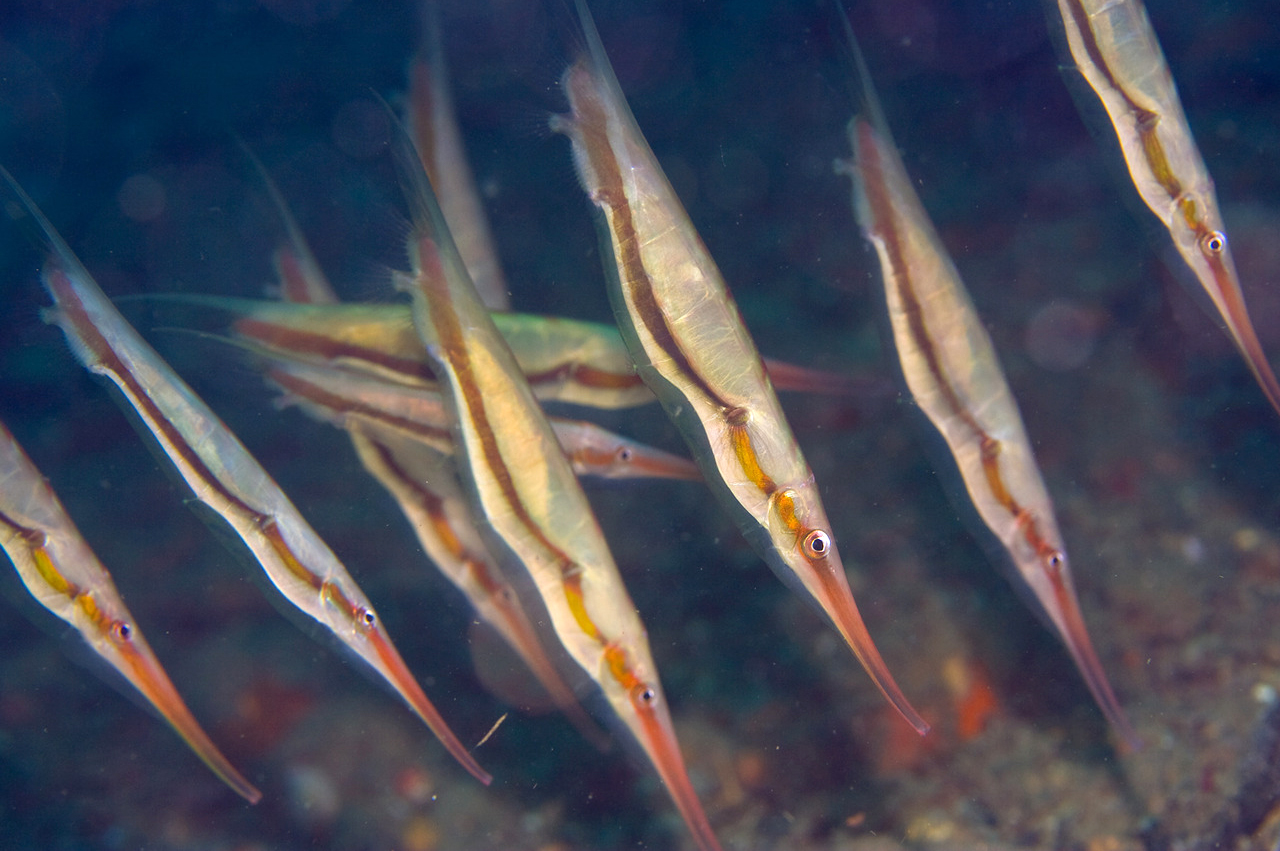Jointed Razorfish, Aeoliscus strigatus (Günther 1861)

Jointed Razorfish, Aeoliscus strigatus, at Sorong, Raja Ampat Islands, West Papua, Indonesia, depth 6 m. Source: orangkucing / http://orangkucing.tumblr.com/. License: CC by Attribution-ShareAlike
The remarkable Jointed Razorfish has a rigid ‘razor-thin’ body encased in transparent 'armour', a long pointed snout and a jointed dorsal-fin spine. They are yellowish-brown to pale green on the back, and silvery on the sides, with a dark mid-lateral stripe along the body. The first dorsal-fin spine is 'jointed' or hinged and often held at an angle to the body. Jointed Razorfish often swim in large synchronised schools, and seek refuge amongst coral branches or sea urchin spines.
Jointed Razorfish, Aeoliscus strigatus (Günther 1861)
More Info
|
Distribution |
Tropical Indo-West Pacific, from East Africa to Australia and north to southern Japan. Known in Australian waters from the tip of Cape York, northern Queensland to northern NSW. This schooling species lives on coral reefs in sheltered bays and lagoons on the continental shelf at 1–42 m. Jointed Razorfish live in association with a variety of invertebrates such as Acropora corals, gorgonians, black corals, sea whips, Diadema sea urchins and seagrasses. |
|
Features |
Meristic features: Dorsal fin III, 10; Anal fin 12; Pectorla fin 11–12; Pelvic fin 4. Body elongate, extremely compressed, encased in protective transparent sutured plates; ventral edge very compressed, 'sharp'; interorbital space striated, convex, longtitudinal agroove absent; snout long and tubular; mouth small, teeth absent; lateral line absent. Caudal and soft dorsal fins situated ventrally; spinous dorsal fin hinged, and positioned at end of body where the caudal fin is usually found. |
|
Size |
To 15 cm. |
|
Colour |
Colour varies with habitat,ranging from a silvery greenish- to yellowish-brown, or quite pale. Individuals living amongst seagrasses have tend to be more greenish-yellow body with a diffused longitudinal stripe from the snout to the tail fin. Those in sandy or rubble habitats are often paler with a black longitudinal stripe. |
|
Feeding |
Carnivoer - feeds on tiny planktonic invertebrates, especially crustaceans. |
|
Biology |
Oviparous, sexes separate, fertilisation external. Eggs and larvae are pelagic, juveniles settle at about 20 mm in length, often within the spines of the sea urchin Diadema. |
|
Fisheries |
The Jointed Razorfish may be taken as bycatch in commerical fisheries. Although this species is collected for the aquarium industry, individuals are difficult to keep in captivity. |
|
Conservation |
Not evaluated. |
|
Remarks |
Razorfish usually swim in a head-down position, moving in the direction of their dorsal surface. |
|
Similar Species |
Jointed Razorfish differ from members of the genus Centriscus in having a jointed, versus a rigid first dorsal-fin spine. The other species of Aeoliscus, A. punctulatus, occurs in the Western Indian Ocean and the Red Sea, and differs in having small black spots over body. |
|
Etymology |
Aeoliscus is derived from Aeolius, a region from Asia Minor and Aeolus, the Greek god of winds. The species name strigata is from the Latin meaning stripe in reference to the dark stripe along the sides. |
|
Species Citation |
Amphisile strigata Günther 1861, Cat. Fish. Brit. Mus. 3: 528. Type localith: Java, Indonesia. |
|
Author |
Dianne J. Bray & Vanessa J. Thompson |
Jointed Razorfish, Aeoliscus strigatus (Günther 1861)
References
Allen, G.R. 1997. Marine Fishes of Tropical Australia and South-east Asia. Western Australian Museum. 292 p.
Fritzsche, R.A. & K.G. Thiesfeld. 1999. Centriscidae: Shrimpfishes (razorfishes), p. 2281-2282 In Carpenter, K.E. & V.E. Niem. Species identification guide for fisheries purposes. The living marine resources of the western central Pacific. Bony fishes part 2 (Mugilidae to Carangidae). FAO, Rome.
Günther, A. 1861. Catalogue of the acanthopterygian fishes in the collection of the British Museum. 3. Gobiidae, Discoboli, Pediculati, Blenniidae, Labyrinthici, Mugilidae, Notacanthi. London. 3: i-xxv + 1-586 + i-x.
Hoese, D.F., Bray, D.J., Paxton, J.R. & Allen, G.R. 2006. Fishes. In Beesley P.L. & Wells A. (eds) Zoological catalogue of Australia. Volume 35 ABRS & CSIRO Publishing: Australia. 3 volumes.
Kuiter, R.H. 1996. Guide to Sea Fishes of Australia. New Holland.
Kuiter, R.H. 2009. Seahorses and their relatives. Aquatic Photographics, Seaford, Australia, 333 p.
Leis, J.M. & Rennis, D.S. 2000. Centriscidae (Razorfishes) In Leis J.M. and Carson-Ewart B.M. (eds) The Larvae of Indo-Pacific Coastal Fishes: An identification guide to marine fish larvae. Brill, The Netherlands.
Michael, S.W. 2001. Reef Fishes Volume 1: A guide to their identification, behaviour and captive care. TFH Publications Inc., New Jersey, USA.
Okiyama, M. 1988. An atlas of the early stage fishes in Japan. Tokai University Press, Tokyo. 1157 pp. [In Japanese]
Randall, J.E. 2005. Reef and shore fishes of the South Pacific. University of Hawai’i Press Honolulu.
Randall, J.E., Allen, G.R. & Steene, R.C. 1997. Fishes of the Great Barrier Reef and Coral Sea. Crawford House Publishing Bathurst.
Russell, B.C. & W. Houston. 1989. Offshore fishes of the Arafura Sea. The Beagle 6(1): 69-84.
Whitley, G.P. & Allan, J. 1958. The sea-horse and its relatives. The Griffin Press, Adelaide, Australia.





